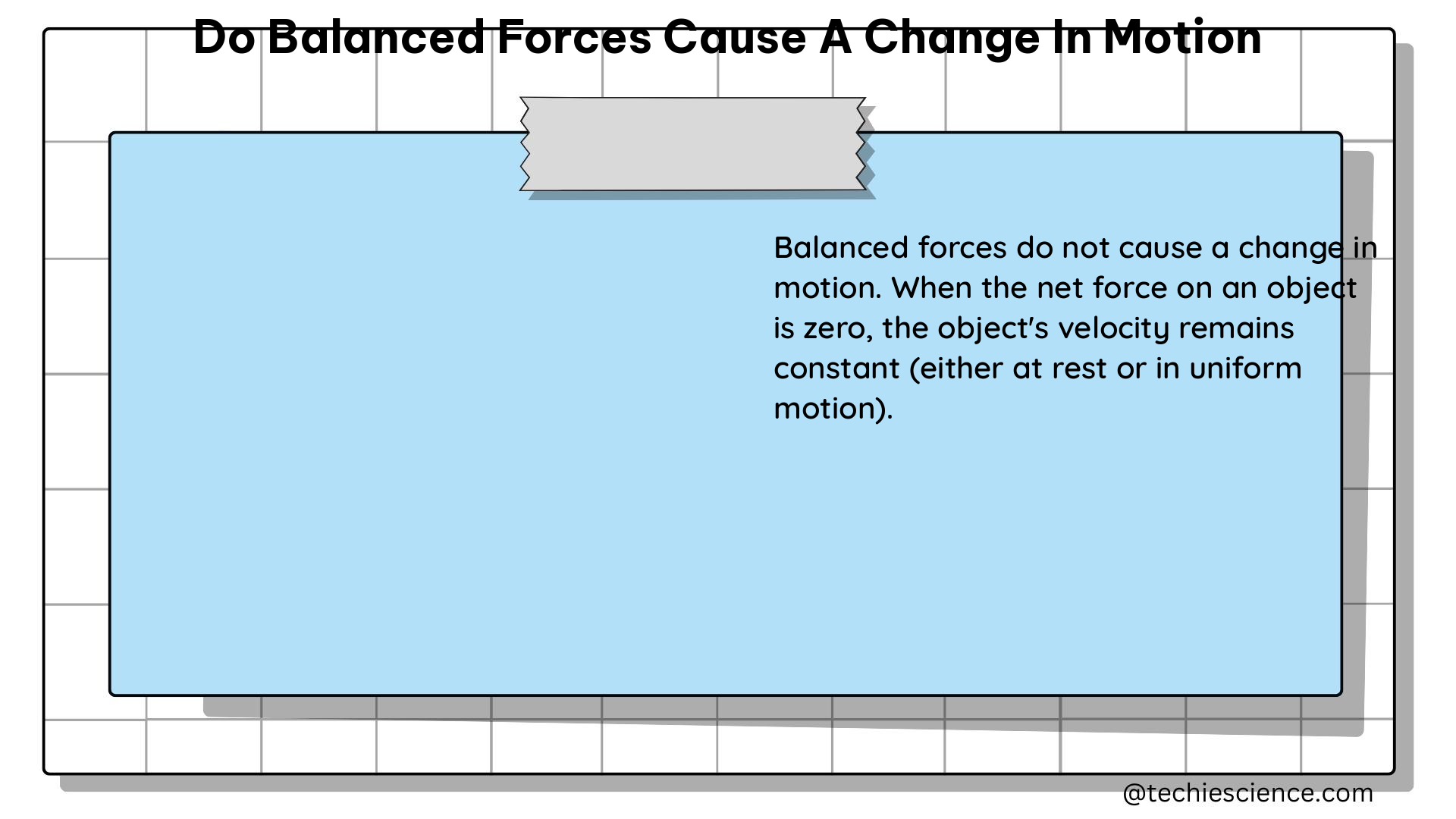Balanced forces are a fundamental concept in physics, and understanding their relationship with motion is crucial for students and researchers alike. This comprehensive blog post aims to provide a detailed and technical exploration of the topic, equipping readers with a deep understanding of the subject matter.
The Concept of Balanced Forces
Balanced forces are defined as a set of forces acting on an object that sum up to zero. In other words, the net force acting on the object is zero. This means that the object is not experiencing any acceleration, as per Newton’s second law of motion, which states that the acceleration of an object is directly proportional to the net force acting on it and inversely proportional to its mass.
Mathematically Expressing Balanced Forces
Mathematically, the condition for balanced forces can be expressed as:
$\sum F = 0$
Where $\sum F$ represents the vector sum of all the forces acting on the object.
The Relationship Between Balanced Forces and Motion

The key question at hand is whether balanced forces cause a change in motion. To answer this, we need to delve deeper into the underlying principles and supporting evidence.
Newton’s First Law of Motion
According to Newton’s first law of motion, also known as the law of inertia, an object at rest will remain at rest, and an object in motion will remain in motion, unless acted upon by an unbalanced force. This law directly implies that balanced forces do not cause a change in motion.
Proof Using Newton’s First Law
Consider an object at rest. If the forces acting on the object are balanced, the net force is zero, and the object will remain at rest, as per Newton’s first law. Similarly, if an object is in motion and the forces acting on it are balanced, the net force is still zero, and the object will continue to move at a constant velocity, without any change in its motion.
Quantitative Evidence from Experiments
Numerous experiments and observations have provided quantitative evidence to support the claim that balanced forces do not cause a change in motion. Here are a few examples:
-
Tug-of-War Experiment: In a tug-of-war scenario, if the forces exerted by the two teams are balanced, the marker remains stationary. However, if the forces become unbalanced, the marker starts moving in the direction of the stronger force.
-
Inclined Plane Experiment: Consider an object placed on an inclined plane. If the normal force and the force of gravity acting on the object are balanced, the object will remain at rest. If the forces become unbalanced, the object will start accelerating down the incline.
-
Centripetal Force Experiment: In circular motion, the centripetal force and the centrifugal force are balanced, causing the object to move in a circular path at a constant speed. If the forces become unbalanced, the object will experience a change in its motion, either in speed or direction.
Numerical Examples
To further illustrate the concept, let’s consider a few numerical examples:
- Example 1: A 5 kg object is acted upon by two equal and opposite forces of 10 N each. The net force is zero, and the object remains at rest.
$\sum F = 0 \implies a = 0$
- Example 2: A 2 kg object is moving at a constant velocity of 5 m/s. The forces acting on the object are balanced, with a total force of 10 N in the direction of motion and 10 N in the opposite direction.
$\sum F = 0 \implies a = 0$
- Example 3: A 3 kg object is placed on a frictionless inclined plane with an angle of 30 degrees. The force of gravity acting on the object is 29.4 N, and the normal force is 25.5 N. The net force is zero, and the object remains at rest.
$\sum F = 0 \implies a = 0$
These examples clearly demonstrate that balanced forces do not cause a change in motion, as the net force is zero, and the object either remains at rest or continues to move at a constant velocity.
Factors Affecting the Change in Motion
While balanced forces do not cause a change in motion, it is important to understand the factors that can lead to a change in motion. These factors are typically associated with unbalanced forces.
Unbalanced Forces and Acceleration
When the forces acting on an object are unbalanced, the net force is non-zero, and the object will experience acceleration. The acceleration can be calculated using Newton’s second law of motion:
$a = \frac{\sum F}{m}$
Where $a$ is the acceleration, $\sum F$ is the net force, and $m$ is the mass of the object.
Examples of Unbalanced Forces Causing a Change in Motion
-
Pushing an Object: When you push an object, the force you apply is greater than the opposing force, resulting in a net force and causing the object to accelerate.
-
Throwing a Ball: When you throw a ball, the force of your hand is greater than the force of air resistance, causing the ball to accelerate and change its motion.
-
Braking a Car: When you apply the brakes in a car, the frictional force between the brake pads and the wheels is greater than the force of the engine, causing the car to decelerate.
Conclusion
In conclusion, the evidence presented in this blog post clearly demonstrates that balanced forces do not cause a change in motion. The underlying principles, supported by mathematical expressions, Newton’s laws of motion, and quantitative experiments, all point to the fact that balanced forces maintain the status quo, while unbalanced forces are responsible for changes in motion.
This understanding is crucial for students and researchers in various fields of physics, as it forms the foundation for analyzing and predicting the behavior of objects under the influence of different forces.
References
- Quizlet Flashcards: Balanced/Unbalanced Forces
- NGSS Disciplinary Core Ideas: Motion and Stability: Forces and Interactions
- K-12 Alliance Lesson Plan: Balanced and Unbalanced Forces
- Physics Classroom: Newton’s First Law
- Khan Academy: Balanced and Unbalanced Forces

I am Alpa Rajai, Completed my Masters in science with specialization in Physics. I am very enthusiastic about Writing about my understanding towards Advanced science. I assure that my words and methods will help readers to understand their doubts and clear what they are looking for. Apart from Physics, I am a trained Kathak Dancer and also I write my feeling in the form of poetry sometimes. I keep on updating myself in Physics and whatever I understand I simplify the same and keep it straight to the point so that it deliver clearly to the readers.